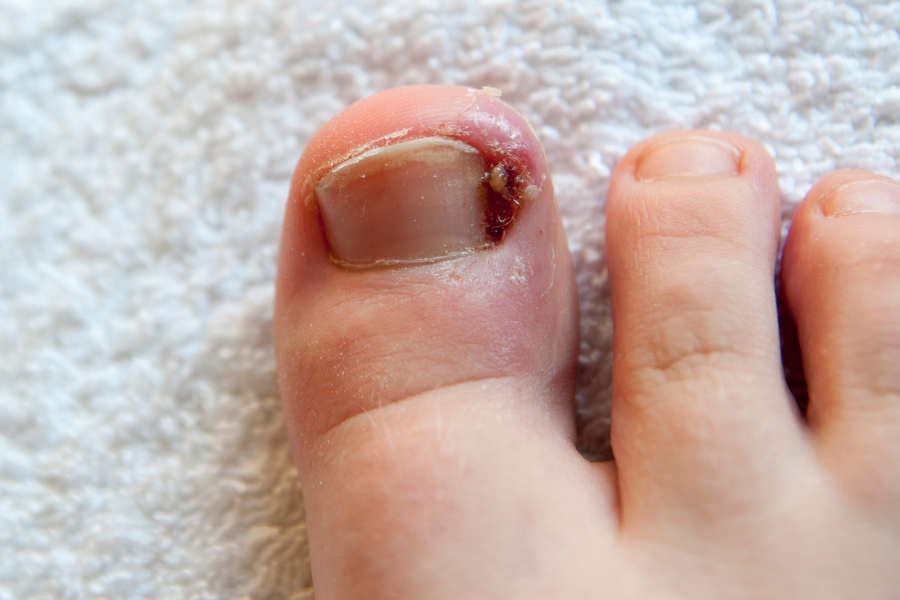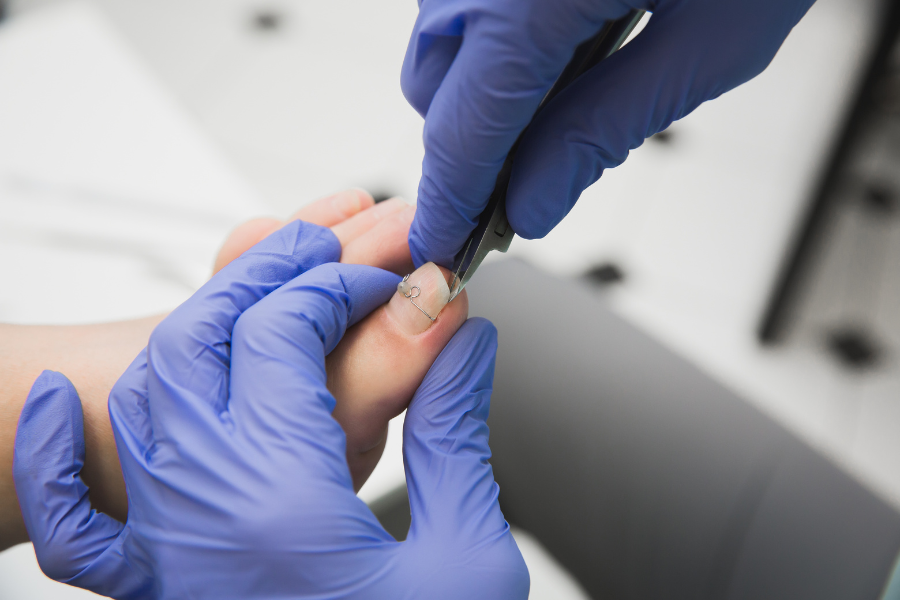 What is an ingrown toenail?
What is an ingrown toenail?- Why do I have an ingrown toenail?
- How can I tell if I have an ingrown toenail?
- How can I tell if my ingrown toenail is infected?
- How can I fix an ingrown toenail?
- How do I prevent ingrown toenails?
- Should I see a foot doctor?
If you are like most people, your feet can take a lot of abuse without becoming injured or bothering you. Because our feet are so tolerant and study, they are body parts that we often pay very little attention to—at least until they start to hurt. Your feet carry your entire body weight, so it shouldn’t be a surprise when they sustain injuries.
From cramming your toes into pointy shoes to flattening your arch with flip-flops, our feet can become strained or injured just from the rigors of our daily activities. Your feet will usually signal that something is wrong when you’ve pushed them past their limit. Generally, when your feet are unhappy, you are, too.
One common foot complaint handled by the doctors at Celebration Foot and Ankle is ingrown toenails. Although you can treat an ingrown toenail at home, the area can become infected, causing your foot to become tender and sore.
To help you better understand your options, we’ll discuss what an ingrown toenail is, what causes it, and what you can do to remedy this oftentimes painful condition.
What Is an Ingrown Toenail?
Ingrown toenails happen when a toenail grows into the skin at the side of the nailbed, usually in the big toe area. In most cases, ingrown toenails are caused when you trim the toenail too short on the sides. Most people clip both sides of their toenails into a taper to better fit how the toe grows. This can encourage the nail to grow incorrectly into the skin. An ingrown toenail can also develop if your shoes are too short or tightly fighting.
In medical terms, ingrown toenails are known as unguis incarnates or onychocryptosis.
Why Do I Have an Ingrown Toenail?
 Improper nail trimming and ill-fitting shoes are two reasons you might develop an ingrown toenail. However, patients with diabetes are also at a higher risk of developing this condition. Similarly, individuals who are overweight or have poor blood circulation are also more likely to develop an ingrown toenail.
Improper nail trimming and ill-fitting shoes are two reasons you might develop an ingrown toenail. However, patients with diabetes are also at a higher risk of developing this condition. Similarly, individuals who are overweight or have poor blood circulation are also more likely to develop an ingrown toenail.
Other causes of ingrown toenails include:
- Congenital issues, such as the shape of your foot or toenail
- Nerve damage to the feet or legs
- Trauma to the toe
Approximately 2.5% to 5% of the population experience an ingrown toenail at some point in their lives. Ingrown toenails account for around 20% of all foot problems that doctors see.
How Can I Tell if I Have an Ingrown Toenail?
The typical signs of an ingrown toenail include:
- Infection
- Pain and discomfort
- Red and inflamed skin
- Swelling and puffiness
While you may be able to treat an ingrown toenail at home, there are some troubling signs you should look for that may need to be seen by a doctor. These typically indicate that the toe has become severely infected. Nearly everyone who experiences an ingrown toenail will have these symptoms.
How Can I Tell if My Ingrown Toenail Is Infected?
 Without adequate treatment, ingrown toenails can worsen and become infected. If the toe becomes infected, you may recognize symptoms such as:
Without adequate treatment, ingrown toenails can worsen and become infected. If the toe becomes infected, you may recognize symptoms such as:
- Bleeding
- Oozing pus
- Skin overgrowth around the toe area
Doctors identify these three distinct stages in the development of an ingrown toenail:
- Stage 1: The nail grows into the side of the skin, causing redness and discomfort
- Stage 2: New tissue has grown over the edges of the nail and is inflamed, hot, and uncomfortable
- Stage 3: Chronic inflammation, infection, and pus are present
At stage three, it can become difficult to walk. While early-stage ingrown toenails can respond to home treatments, stage three usually means it’s time to seek help from your doctor.
How Can I Fix an Ingrown Toenail?
 You can try treating an ingrown toenail at home as long as it isn’t infected. These DIY treatments can alleviate pain and help with symptoms:
You can try treating an ingrown toenail at home as long as it isn’t infected. These DIY treatments can alleviate pain and help with symptoms:
- Carefully pry up the nail and place a cotton ball or pad between the nail and skin (if you can)
- Saturate the irritated area with antibiotic cream and a bandage
- Soak the foot twice a day in warm water and Epsom salts
- Keep the foot dry (when not soaking it)
- Wear comfortable shoes that don’t put pressure on the toe
- Use over-the-counter pain relievers
Generally, we don’t recommend that you cut your skin or the nail. Cutting the toe could worsen the chances of an infection. In most cases, an ingrown toenail can heal without surgery. In severe cases, or when the toe becomes infected, it’s time to see a doctor.
How Can I Prevent an Ingrown Toenail?
When taking care of your feet, you can do a few things to lessen the chances of developing an ingrown toenail:
- Soak your feet in warm water before cutting nails
- Cut nails right after a bath or shower
- Avoid using a dirty nail trimmer to clip your nails
- Don’t round the nail corners; just trim them across the top
- Wear shoes that fit
- If you have diabetes, make sure you see a doctor to monitor the health of your feet
Is It Time for a Visit to the Foot Doctor?
 Some people experience recurring ingrown toenails. In these cases, your doctor may need to remove some or all of the nail surgically to keep it from growing into the skin. This procedure is called a nail avulsion.
Some people experience recurring ingrown toenails. In these cases, your doctor may need to remove some or all of the nail surgically to keep it from growing into the skin. This procedure is called a nail avulsion.
During this procedure, the doctor numbs the area and then removes the problem nail. Over the next few months, the nail will regrow properly. In a few severe cases, the doctor also may elect to kill the root of the nail if repeated ingrown toenails plague you.
Two out of 10 people who see their doctor for a foot issue also experience an ingrown toenail. Celebration Foot and Ankle’s team is committed to helping you improve the health of your feet. Your feet are your foundation—taking better care of them can help prevent lasting injuries that interrupt your daily life and decrease mobility over time.
Talk with one of our foot and ankle experts today to get your feet the treatment they deserve.


